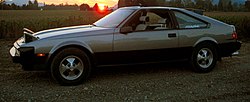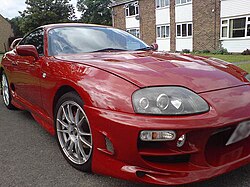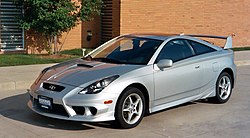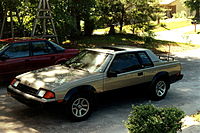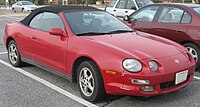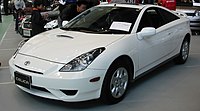Toyota Supra
From Wikipedia, the free encyclopedia
| This article needs additional citations for verification. Please help improve this article by adding reliable references. Unsourced material may be challenged and removed. (August 2007) |
- This article is about the automobile. For other uses, see Supra (disambiguation).
| Toyota Supra | |
|---|---|
 | |
| Manufacturer | Toyota |
| Also called | Toyota Celica Supra |
| Production | 1979-2002 |
| Assembly | Japan |
| Predecessor | Toyota 2000GT |
| Class | Sports car Grand Tourer |
| Body style(s) | 2+2 fastback[1][2], GT coupe[1][2] |
| Layout | FR layout |
The Toyota Supra was a sports car/grand tourer produced by Toyota Motor Company from 1979 to 2002. The styling of the Toyota Supra was derived from the Toyota Celica, but it was both longer and wider.[3] Starting in mid-1986, the Supra (in its third generation, MKIII) became its own model and was no longer based on the Celica. In turn, Toyota also stopped using the prefix Celica and began just calling the car Supra.[4] Due to the similarity and past of the Toyota Celica's name, it is frequently mistaken for the Toyota Supra, and vice versa.
The Supra also traces much of its roots back to the Toyota 2000GT with the main instance being its engine. The first three generations were offered with a direct descendant to the 2000GT's M engine. All four generations of Supra produced have an inline 6-cylinder engine.
Along with this name and car Toyota also included its own logo for the Supra. It is derived from the original Celica logo, being blue instead of orange. This logo was used until January 1986, when the MKIII Supra was introduced. The new logo was similar in size, with orange writing on a red background, but without the dragon design. That logo, in turn, was on Supras until the 1989 redesign when Toyota switched to its current oval company logo.
In 1999, Toyota ceased sales of the Supra in the United States[4] and in 2002 Toyota officially stopped production of the Supra in Japan.
As an iconic sportscar, the Supra has appeared in numerous video games, movies, music videos and TV shows. Some of the most notable appearances include the Gran Turismo and Need for Speed series of video games and the 2001 film, The Fast and the Furious.
Contents[hide] |
[edit] Mark I (1979-1981)
| Mark I | |
|---|---|
 | |
| Also called | Toyota Celica Supra MK I |
| Production | 1979-1981 |
| Platform | MA4x |
| Engine(s) | 2.0 L (1988 cc) M-EU I6 2.0 L (1988 cc) M-TEU I6 2.6 L (2563 cc) 4M-E I6 2.8 L (2759 cc) 5M-E I6 |
| Transmission(s) | 5-speed W50 manual 4-speed A40D automatic 4-speed A43D automatic |
| Wheelbase | 103.5 in (2628.9 mm) |
| Length | 181.7 in (4615.2 mm) |
| Width | 65.0 in (1651.0 mm) |
| Height | 50.8 in (1290.3 mm) |
| Curb weight | ~2800 lb (1270.1 kg) |
| Fuel capacity | 16.1 U.S. gal (60.4 L) [1] |
The first generation Supra was based largely upon the Toyota Celica liftback, but was longer by 5.1 in (129.5 mm). The doors and rear section stayed the same length as Celica but rear panels differed. The most important change was the swap to an Inline-6 instead of the stock Celica's 4-cylinder engine. Toyota's original plan for the Supra at this time was to make it a competitor to the very popular Datsun (now Nissan) Z-car.
[edit] 1979
In 1978 Toyota began production of the Mark I Supra in Japan, as the Toyota Celica XX. The year it debuted in the United States and Japan was in 1979. The USA Mark I (chassis code MA46) was originally equipped with a 110 hp (82 kW) 2.6 L (2563 cc) 12-valve SOHC inline-6 engine (4M-E). Simultaneously in 1979, the Japanese Mark I (chassis code MA45) was offered with a 110 hp (82 kW) 2.0 L 12-valve SOHC inline-6 engine (M-EU). Both were the first Toyota engines equipped with electronic fuel injection.[4][5]
Drivetrain options for the Mark I were either a 5-speed manual (W50) or an optional 4-speed automatic transmission (A40D). Both transmissions featured an overdrive gear. The top gear in the 5-speed was its overdrive gear whereas the automatic transmission featured an overdrive gear that would engage at speeds over 35 mph (56 km/h). The drivetrain for the Supra retained the T series solid rear axle configuration of the Celica in the Japanese MA45 version and a larger F series (and optional Limited Slip Differential) in the MA46 and MA47. The car also came standard with 4-wheel disc brakes and featured a four-link rear suspension with coil springs, lateral track bar, and stabilizer bar. The front suspension consisted of MacPherson struts and a stabilizer bar.
On the inside of the Supra one had an option of power windows and power locks as part of the convenience package. The convenience package also included cruise control and special door trim with door pull straps, with an optional sunroof. As for standard features, in the center console there was an extendable map light and a fliptop armrest, which provided storage. Some other features were the tilt steering wheel, deep zippered pockets on the backs of the front seats, and tonneau cover under the liftback. The dashboard also contained a state-of-the-art (at the time) AM/FM/MPX 4-speaker stereo radio, analog clock, and tachometer as part of the instrument panel.
[edit] 1980
In 1980, the Japanese Mark I (also branded with the MA46 chassis code) was offered with a 145 hp (108 kW) 2.0 L (1988 cc) 12-valve SOHC Turbocharged inline-6 engine (M-TEU). The engine was equipped with a Garrett T03 Turbo, but was not intercooled. This was the first Toyota engine to utilize a turbocharger.[5]
The changes for the 1980 US version were different, but mostly cosmetic. The interior received a redesigned center console and a digital quartz clock. On the exterior were redesigned side view mirrors, the 14x5.5 aluminum rims, which were optional in 1979, are now standard (the 1979s had steel rims with plastic wheel covers standard). In addition body molded mudflaps became available. On the copper metallic and white cars the mudflaps were painted the body color while the mudflaps were left black on all other colors. On the rear of the mudflaps, the word "Celica" was painted in white lettering.[6]
The official Toyota Supra Site[4] also notes that there was an addition of optional leather-trimmed seating and automatic climate-control.
[edit] 1981
In the coming year, 1981, the Supra received an upgrade in displacement with the 2.8 L (2759 cc) 5M-E engine. It is still a 12-valve SOHC engine, but makes 116 hp (87 kW) and 145 ft·lbf (197 N·m) of torque. The cars automatic transmission was changed to the revised Toyota A43D and it gained a revised final drive gearing. Because of the change in engine and transmission they dubbed a new chassis code of MA47. The final year of the MK I Supra it achieved a 0-60 mph time of 10.24 seconds and finished the 1/4 mile in 17.5 seconds at 77.7 mph.[1]
Also in 1981, a new Sports Performance Package became an option, which included sport suspension, raised white letter tires, and front and rear spoilers. This also marked the last year that the 8-track cartridge was offered in any Supras.[4][6]
[edit] Quick info
| Code | Year | Engine | Power | Torque | Transmission | Market |
|---|---|---|---|---|---|---|
| MA45 | 1979 | 2.0 L (1988 cc) M-EU I6 | 110 hp (82 kW) | 136 ft·lbf (184 N·m) | 5-speed W50 manual 4-speed A40D automatic | JPN |
| MA46 | 2.6 L (2563 cc) 4M-E I6 | 110 hp (82 kW) | 136 ft·lbf (184 N·m) | USA | ||
| 1980 | 2.0 L (1988 cc) M-TEU turbo I6 | 145 hp (108 kW) | 156 ft·lbf (211 N·m) | JPN | ||
| 2.6 L (2563 cc) 4M-E I6 | 110 hp (82 kW) | 136 ft·lbf (184 N·m) | USA | |||
| MA47 | 1981 | 2.8 L (2759 cc) 5M-E I6 | 116 hp (87 kW) | 145 ft·lbf (197 N·m) | 5-speed W50 manual 4-speed A43D automatic | JPN USA |
[edit] Mark II (1982-1986)
| Mark II | |
|---|---|
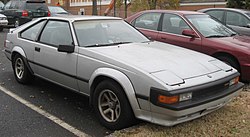 | |
| Also called | Toyota Celica Supra MK II |
| Production | 1982-1986 |
| Platform | MA6x GA6x |
| Engine(s) | 2.0 L (1988 cc) M-TEU I6 2.0 L (1988 cc) M-TE I6 2.0 L (1988 cc) 1G-EU I6 2.0 L (1988 cc) 1G-GEU I6 2.8 L (2759 cc) 5M-E I6 2.8 L (2759 cc) 5M-GE I6 |
| Transmission(s) | 5-speed W58 manual 4-speed A43DL automatic 4-speed A43DE automatic |
| Wheelbase | 102.9 in (2613.7 mm) |
| Length | 183.5 in (4660.9 mm) |
| Width | 67.7 in (1719.6 mm) |
| Height | 52.0 in (1320.8 mm) |
| Curb weight | ~3000 lb (1360.8 kg) |
| Fuel capacity | 16.1 U.S. gal (60.4 L) |
In 1982, Toyota completely redesigned the Celica Supra as well as the entire Celica lineup. In Japan, they were known as Celica XX, but everywhere else the Celica Supra name stuck. Still being based around the Celica platform, there were several key differences, most notably the design of the front end and fully retractable pop-up headlights. Other differences would be the inline-6 still present in the Supra instead of the inline-4 as well as an increase in length and wheel base to conform with the overall larger engine. Toyota's continued market competition with Nissan is shown by the Supra's use of a rear hatch sun shade to avoid the louvers popularly associated with the Z car.
[edit] L-type and P-type
In the North American market, the Celica Supra was available in two distinct models. There was the Performance Type (P-type henceforth) and the Luxury Type (L-type henceforth). While being mechanically identical, they were differentiated by the available options; tire sizes, wheel sizes, and body trim. The P-type had fiberglass fender flares over the wheel wells, while the L-type did not. The P-type was also standard with the more sporty 8-way adjustable seats. The P-type did not get the option of a leather interior until 1983. All editions of the P-Type had the same 14x7 aluminum alloy rims and throughout the years the L-Type had 14"x5.5" rims until 1985 when they were changed to a P-type style 15x6. The L-type also had the option of a digital dash with trip computer, whereas the P-Type was only offered with an analog dash (with digital clock). The digital dash featured a digital tachometer, digital speedometer, and electronic fuel level and coolant level gauges. The trip computer could calculate and display various things such as fuel economy in miles-per-gallon, estimated time of arrival (ETA), and distance remaining to destination. Excluding the 1982 model, all P-types were available with headlight washers as an option, but the L-types were never fitted with such an option. Although gear ratios changed throughout the years all P-types came as standard with a limited slip differential.
[edit] 1982
In the North American market, the Celica Supra's engine was the 2.8 L (2759 cc) 12-valve (2 valves per cylinder) DOHC 5M-GE. Power output was 145 hp (108 kW) and 155 ft·lbf (210 N·m) of torque. The engine utilized an 8.8:1 compression ratio to achieve the power and featured a vacuum advanced distributor. When the car debuted it clocked a 0-60 time of 9.8 seconds and netted a 17.2 second 1/4 at 80 mph (130 km/h)[7]
The standard transmission for this year was the W58 5-speed manual with the A43DL 4-speed automatic transmission being an option for L-types. Both transmissions featured an overdrive gear and the automatic featured a locking torque converter. The top gear in the 5-speed was its overdrive whereas the automatic transmission featured an overdrive gear that would engage at speeds over 35 mph (56 km/h). The 1982 models' rear differential featured a 3.72:1 ratio. The Celica Supra's 4-wheel independent suspension was specially tuned and designed by Lotus and featured variable assisted power rack-and-pinion steering and MacPherson struts up front. As for the rear, it had semi-trailing arm suspension with coil springs and a stabilizer bar. Braking on the Celica Supra was handled by 4-wheel disc brakes.
On the inside this generation had standard power windows, power door locks, and power mirrors as well as a tilt steering wheel. The power door lock was located in the center console next to the power mirror control. The analog dash of this year only went to 85 mph (137 km/h) in North America. The optional automatic climate control on the MK I was renovated and was now seen as a standard feature on the MK II. Cruise control was standard in this generation. Toyota also included the retractable maplight as standard, just like with MK I Supras. Some options included the addition of a sunroof, two-tone paint schemes, and 5-speaker AM/FM/MPX tuner with cassette. The optional cassette stereo featured a 105-watt power amplifier and a 7-channel graphic equalizer to control tone. The standard stereo was a 5-channel AM/FM/MPX tuner. Leather was an option on L-Types this year, but P-types were stuck with standard striped cloth.
As far as the outside goes there was no external antenna it was simply located in the front windshield. There was a key lock on the gas tank door and the hatch and bumper were black no matter what color the rest of the car was. The P-types were available with an optional rear sunshade above the hatch glass. The lights in the rear featured a reverse light in the center and the door handles opened the doors by pulling sideways. The front nose badge and B-pillar only read "SUPRA". Although it is believed mudflaps weren't introduced on this generation until 1983, all L-types had front and rear mudflaps.
[edit] 1983
For the 1983 models not much was altered, but there was an increase in power output to: 150 hp (112 kW) and 159 ft·lbf (216 N·m) of torque from the same 5M-GE. The only real change in the engine area was the switch to an electronic advanced distributor, yet that did not increase the power. Toyota switched to a 4.10:1 rear gear ratio for the P-Type and a 3.73:1 for the L-Type. As for the optional automatic transmission they switched out the A43DL 4-speed for a newly designed A43DE 4-speed. It featured an electronic controller that would adjust its shift pattern for a balance between performance and economy. It was the first in the industry to provide an "Electronically Controlled Transmission" (ECT). This allowed the driver to choose either the "Power" driving mode or "Normal" driving mode at the touch of the button. The "Power" mode provided the quickest acceleration and the "Normal" mode provided the best all-around performance.
On the inside of the car there were virtually no changes, but on the outside they decided to switch to a power antenna and it was the first year both the P-Type and L-Type had standard mudflaps. The B-pillar and nose badge were changed to say "Celica Supra" now and only L-Types were available in two-tone color schemes.
[edit] 1984
In 1984, Toyota changed quite a bit on the Supra. Power output was increased on the 5-speed models with a bump up to 160 hp (119 kW) and 163 ft·lbf (221 N·m) of torque. The increase was achieved by a mixture of a redesigned intake manifold with "D"-shaped intake runners and an increase in compression ratio to: 9.2:1[3]. Another notable change in the 5-speeds was the switch to a 4.30:1 gear ratio in the rear differential. All automatic Supra's retained the previous years power numbers, but the rear gear ratio was changed to a 4.10:1.
The most notable exterior change was the switch to wraparound front turn signals. Also on the outside the tail-lights were redesigned and the hatch received a billboard "SUPRA" sticker instead of the smaller sticker, which was previously positioned on the right. The rear hatch and bumper was changed and received the same color as the rest of the car (instead of the black of previous years). The door handles were also switched around, opening by pulling up instead of sideways. This year Toyota also decided to offer two-tone paint schemes on both the P-Type and L-Type.
Some interior controls such as the steering wheel, cruise control, and door lock switch were redesigned. Toyota encompassed a 130 mph (210 km/h) speedometer instead of the traditional 85 mph (137 km/h) one and the automatic climate control display was also changed. The previous year's cassette/equalizer stereo option was now made a standard feature.
[edit] 1985-1986
The Supra was altered again in 1985. On the engine side, power output was increased to 161 hp (120 kW) and 169 ft·lb (229 N·m) of torque. The good news was that all Supras this year had that same amount of power (both automatics and 5-speeds). The engine received a redesigned throttle position sensor (TPS) as well as a new EGR system and knock sensor. With the slight increase in power the Supra was able to propel itself from 0-60 mph in 8.4 seconds and netting a 16.1 second quarter mile at 85 mph (137 km/h). [8]
Other changes would be a redesigned, more "integrated" sunshade and spoiler on the rear hatch. The rear spoiler was changed from a one piece to a two piece spoiler. Oddly the L-types of this year were not available with a leather interior, but P-types were. Toyota added a standard factory theft deterrent system and the outside mirrors were equipped with a defogger that activated with the rear defroster. All Supras this year received automatic-off lights that also encompassed an automatic illuminated entry and fade-out system.
While 1985 was to be the last year of the second generation model, delays in production of the third generation model led to a surplus of second generation Supras. During the first half of 1986 the 1985 MK II P-type was still offered for sale, with only minor cosmetic changes as well as the addition of a now mandatory rear-mounted third brakelight on the hatch. These were all labeled officially as 1986 models. P-types were the only model available in 1986.
[edit] MK IIs around the world
The second generation Supra came in a variety of options around the world as well as only being offered during select years.
[edit] Most of Europe
- Sold from 1982-1986.
- 82-83: 2.8 L (2759 cc) DOHC 5M-GE 174 hp (130 kW) and 207 ft·lbf (287 N·m) of torque. Analog dash, no fender flares.
- 84-86: 2.8 L (2759 cc) DOHC 5M-GE 178 hp (133 kW) and 212 ft·lbf (281 N·m) of torque. Digital dash, P-Type fender flares.
[edit] Great Britain
- Sold from 1982-1986.
- 82-83: 2.8 L (2759 cc) DOHC 5M-GE 178 hp (133 kW) and 212 ft·lbf (281 N·m) of torque. Analog dash, no fender flares.
- 84-86: 2.8 L (2759 cc) DOHC 5M-GE 178 hp (133 kW) and 212 ft·lbf (281 N·m) of torque. Digital dash, P-Type fender flares.
[edit] Australia, Sweden, & Switzerland
- Sold from 1984-1986.
- 2.8 L (2759 cc) SOHC 5M-E 116 hp (87 kW) and 145 ft·lbf (197 N·m) of torque.
- The 84 Supra in Australia had a digital dash, fender flares, 82-83 style lights, single piece spoiler and optional sunroof.
- In Australia, the Toyota Supra manufactured between 1982-1990, was assessed in the Used Car Safety Ratings 2006 as providing "worse than average" protection for its occupants in the event of a crash.
[edit] New Zealand
- Sold from 1984-1985
- 2.8 L (2759 cc) DOHC 5M-GE 178 hp (133 kW) and 212 ft·lbf (281 N·m) of torque. Digital dash, P-Type fender flares.
[edit] Japan
- Further information: Toyota Celica XX
[edit] Quick info
| Code | Year | Engine | Power | Torque | Transmission | Market |
|---|---|---|---|---|---|---|
| MA61 | 1982-1983 | 2.8 L (2759 cc) 5M-GE I6 | 174 hp (130 kW) | 207 ft·lbf (287 N·m) | 5-speed W58 manual 4-Speed A43DL automatic (1982) 4-Speed A43DE automatic (1983) | EUR GBR |
| 2.8 L (2759 cc) 5M-GEU I6 | 160 hp (119 kW) | 150 ft·lbf (203 N·m) | 5-speed W58 manual | JPN | ||
| 1984-1986 | 2.8 L (2759 cc) 5M-E I6 | 116 hp (87 kW) | 145 ft·lbf (197 N·m) | 5-speed W58 manual 4-Speed A43DE automatic | AUS CHE SWE | |
| 2.8 L (2759 cc) 5M-GE I6 | 178 hp (133 kW) | 212 ft·lbf (281 N·m) | EUR GBR NZL | |||
| 2.8 L (2759 cc) 5M-GEU I6 | 160 hp (119 kW) | 150 ft·lbf (203 N·m) | 5-speed W58 manual | JPN | ||
| MA63 | 1982 | 2.0 L (1988 cc) M-TEU turbo I6 | 145 hp (108 kW) | 156 ft·lbf (211 N·m) | 4-Speed A43D Automatic | JPN |
| 1983-1985 | 2.0 L (1988 cc) M-TEU turbo I6 | 160 hp (119 kW) | 170 ft·lbf (230 N·m) | |||
| MA67 | 1982 | 2.8 L (2759 cc) 5M-GE I6 | 145 hp (108 kW) | 155 ft·lbf (210 N·m) | 5-speed W58 manual 4-Speed A43DL automatic | CAN USA |
| 1983 | 2.8 L (2759 cc) 5M-GE I6 | 150 hp (112 kW) | 159 ft·lbf (216 N·m) | 5-speed W58 manual 4-Speed A43DE automatic | ||
| 1984 | 2.8 L (2759 cc) 5M-GE I6 | 160 hp (119 kW) | 163 ft·lbf (221 N·m) | 5-speed W58 manual | ||
| 2.8 L (2759 cc) 5M-GE I6 | 150 hp (112 kW) | 159 ft·lbf (216 N·m) | 4-Speed A43DE automatic | |||
| 1985-1986 | 2.8 L (2759 cc) 5M-GE I6 | 161 hp (120 kW) | 169 ft·lbf (229 N·m) | 5-speed W58 manual 4-Speed A43DE automatic | ||
| GA61 | 1982-1985 | 2.0 L (1988 cc) 1G-EU I6 | 125 hp (93 kW) | 127 ft·lbf (172 N·m) | 5-speed W57 manual 4-Speed A43DL automatic | JPN |
| 1982-1985 | 2.0 L (1988 cc) 1G-GEU I6 | 160 hp (188 kW) | 134 ft·lbf (181 N·m) | 5-speed W57 manual |
[edit] Mark III (1986-1992)
| Mark III | |
|---|---|
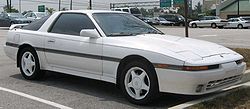 | |
| Also called | Toyota Supra Mark III |
| Production | 1986.5-1992 (1993 in Japan) |
| Platform | MA7x GA7x JZA7x |
| Engine(s) | 2.0 L (1988 cc) 1G-GTE I6 2.5 L (2491 cc) 1JZ-GTE I6 3.0 L (2954 cc) 7M-GE I6 3.0 L (2954 cc) 7M-GTE I6 |
| Transmission(s) | 5-speed W58 manual 5-speed R154 manual 4-Speed A340E automatic |
| Wheelbase | 102.2 in (2595.9 mm) |
| Length | 181.9 in (4620 mm) |
| Width | 68.7 in (1744.9 mm) |
| Height | 1986.5-88: 51.6 in (1310 mm) 1989-92: 51.2 in (1300.5 mm) |
| Curb weight | 5-speed: 3468 lb (1537 kg) 4-speed Auto: 3516 lb (1595 kg) |
| Fuel capacity | 18.5 U.S. gal (70.0 L) [9] |
In the middle of 1986, Toyota was ready to release its next version of the Supra. The official model year is designated as 1986.5. The bonds between the Celica and the Supra were cut; they were now two completely different models. The Celica changed to front wheel drive, while the Supra kept its rear wheel drive platform. Though the Mark II and Mark III had similar designs, the engine was updated to a more powerful 3.0 200 hp (150 kW) inline 6. Although only available in naturally aspirated trim in 1986.5, a turbocharged version of the engine was introduced in the 1987 model year. The Supra was now related mechanically to the Toyota Soarer for the Japanese market.
The new Mark III Supra engine was the flagship engine of Toyota's arsenal. Both versions of the engine contained 4 valves per cylinder and dual overhead cams. The turbocharged 7M-GTE engine was Toyota's first distributor-less engine offered in the U.S which used coil packs sitting on the cam covers and a cam position sensor off of the exhaust camshaft[10]. It was equipped with a CT26 turbocharger and was rated at 230 hp (172 kW) at 5600 rpm while the naturally-aspirated 7M-GE engine was rated at 200 hp (149 kW) at 6000 rpm. Further refinement on the turbo model increased power to 232 hp (173 kW) in 1989. This was mostly due to a redesign of the wastegate.
The naturally aspirated came as standard issue with the W58 manual transmission. The turbo versions included the more robust R154 manual transmission. Both were available with the optional 4-speed A340E automatic transmission.
During the year of 1989, the car received new tail lights, a front bumper, steering wheel, lower redline (due to the heavier crank with cylinders 2 & 5 counterbalanced), badging and side trim amongst other features. Modifications to the wastegate actuator and feed location and engine management netted another 2 hp (1 kW) on the turbo model. For the 1991 model year, the wheel design was changed to 5-spoke wheels. Both models wore 16x7 aluminium alloy wheels that were fitted with 225/50/16 tires and full-sized spares on steel wheels. It was also the last Supra to come with hood struts and a full size spare wheel.
The Supra was also available in two non-export models in Japan, the JZA70 with a 2.5 L 280 hp (209 kW) twin-turbo 1JZ-GTE, known as 2.5GT Twin Turbo (JZA70), and with a 2.0 L 210 hp (157 kW) twin-turbo 1G-GTE.
A special version of the 1JZ-GTE equipped JZA70, the 2.5 Twin Turbo R, had black/grey Recaro seats, a Torsen differential (additional braces to mount the diff), Bilstein suspension and uprated springs, larger sway bars, Momo wheel and gear knob and matching interior trim. This was the fastest factory production version of the MK3 Supra, running a mid 14 second 1/4 mile. The Turbo R also included a change to the R154 gearbox which helped with the well known 1st gear thrust washer problem.
The third-generation Supra represented a great deal of new technology. In 1986, options available for the Supra included 4-channel ABS and TEMS (Toyota Electronically Modulated Suspension) which gave the driver 2 settings which affected the damper rates; a third was automatically activated at WOT, hard braking, and high speed maneuvering. HKS also made a "TEMS Controller" to hack the system and activate it on the fly, though the controllers are now nearly impossible to find.
ACIS (Acoustic Controlled Induction System), a method of controlling air compression pulses inside the intake piping to increase power, was also apart of the 7M-GE's technological arsenal. All models were fitted with double wishbone suspensions front and rear. A targa top was offered along with a metal power sliding sunroof (added in '91).
The 7M-GTE MA71's top speed is 156 mph (251 km/h). Due to an extremely restrictive exhaust, the 7M responds very well to exhaust modifications
[edit] Turbo A
The Turbo-A was Toyota's evolution model for Group A touring car championships all over the world which required a minimum of 500 which were only sold in Japan and was produced between August and September of 1988. Some noted differences between the standard Supra and the Turbo-A model are both cosmetic and some mechanical. The front nose features the ducting to cool the engine, the badging 'turboA' and a Black paint job (all 500 are black). The engine bay features a 267 bhp (199 kW) 7M-GTEU. All Turbo-As also came standard with leather interior.
The car did not win as many races as hoped, being a 3.0 L it was forced to run with more weight where the R32 Skyline GTR didn't have the same restriction and was soon outmoded by the latter when it made its debut in 1990. For the JTCC Toyota would in 1991 switched to racing AE111 Corolla Levins in the lower category until the series final year in 1993. However in the less 'limited' racing it did considerably better.
[edit] Quick info
| Code | Year | Engine | Power | Torque | Transmission | Market |
|---|---|---|---|---|---|---|
| MA70 | 1986.5-1992 | 3.0 L (2954 cc) 7M-GE I6 | 200 hp (149 kW) | 196 ft·lbf (265 N·m) | 5-speed W58 manual 4-speed A340E automatic | CAN EUR USA |
| 3.0 L (2954 cc) 7M-GTE turbo I6 | 230/232 hp (172/173 kW) | 240 ft·lbf (325 N·m) | 5-speed R154 manual 4-speed A340E automatic | CAN EUR JPN | ||
| MA71 | 1987-1992 | 3.0 L (2954 cc) 7M-GTE turbo I6 | 230/232 hp (172/173 kW) | 240 ft·lbf (325 N·m) | 5-speed R154 manual 4-speed A340E automatic | USA |
| GA70 | 1986.5-1992 | 2.0 L (1988 cc) 1G-GTE twin turbo I6 | 185-210 hp (138-157 kW) | 173-203 ft·lbf (222-295 N·m) | 5-speed W58 manual 4-speed A340E automatic | JPN |
| JZA70 | 1990-1992 | 2.5 L (2491 cc) 1JZ-GTE Twin Turbo I6 | 280 hp (209 kW) | 268-272 ft·lbf (363-368 N·m) | 5-speed R154 manual 4-speed A340E automatic | JPN |
[edit] Mark IV (1993-2002)
| Mark IV | |
|---|---|
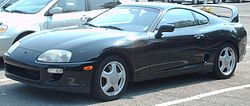 | |
| Also called | Toyota Supra MK IV |
| Production | 1993-2002 |
| Assembly | Motomachi, Japan[11] |
| Platform | JZA8x |
| Engine(s) | 3.0 L (2997 cc) 2JZ-GE I6 3.0 L (2997 cc) 2JZ-GTE I6 |
| Transmission(s) | 5-speed W58 manual 6-speed V16x manual 4-Speed A341E automatic |
| Wheelbase | 100.4 in (2550.2 mm) |
| Length | 1993-98: 177.8 in (4515 mm) 1999-2002: 177.7 in (4513.6 mm) |
| Width | 71.3 in (1811.0 mm) |
| Height | 1999-2002: 50.2 in (1275.1 mm) 1993-98: 49.8 in (1265 mm) |
| Curb weight | non-turbo: ~3210 lb (1460 kg) turbo: ~3505 lb (1580.9 kg) |
| Fuel capacity | 18.5 U.S. gal (70.0 L)[2] |

With the fourth generation of the Supra, Toyota took a big leap in the direction of a more powerful sports car. The new Supra was completely redesigned, with rounded body styling and featured two new engines: a naturally aspirated 2JZ-GE producing 220 hp (164 kW) @5800 rpm and 210 lb·ft (285 N·m) @4800 rpm of torque and a twin turbocharged 2JZ-GTE making 276 bhp (205 kW) and 318 ft·lbf (430 N·m) of torque for the Japanese version. For the export model (America/Europe) Toyota upgraded the Supra turbo's engine (larger turbochargers, bigger fuel injectors, etc.). This increased the power output to 320 hp (239 kW) @5600 rpm and 315 lb·ft (427 N·m) @4000 rpm. The turbocharged variant could achieve 0–60 mph in as low as 4.6 seconds and 1/4 mile (402 m) in 13.1 seconds at 109 mph (175 km/h) [2]. The turbo version was tested to reach over 289 km/h (180 mph) all-stock, but the cars are restricted to just 180 km/h in Japan and 250 elsewhere. European versions also had an air intake on the bonnet (hood). Drag coefficient is .33.
The MKIV Supra's twin turbos operated in sequential mode instead of the more common parallel mode. The sequential setup featured a pair of small, equally sized turbos, with ceramic blades for the domestic Japanese market and steel blades for export (USA, Europe) markets. At first, all of the exhaust is routed to the first turbine for reduced lag. This resulted in boost and enhanced torque as early as 1800 rpm. Approaching 2800 rpm, some of the exhaust is routed to the second turbine for a "pre-boost" mode, although none of the compressor output is used by the engine at this point. Approaching 4000 rpm, the second turbo's output is used to augment the first turbo's output. As opposed to the parallel mode, the sequential turbos provides quicker low RPM response and increased high RPM boost.
For this generation, the Supra received a new 6-speed GETRAG/Toyota gearbox on the Turbo models while the naturally aspirated models made do with a 5-speed manual. Both models were offered with a 4-speed automatic with a manumatic mode. However, the turbo model utilized larger 4-piston brake calipers on the front and 2-piston calipers for the rear. The base model used smaller 2-piston calipers for the front and a single piston caliper for the rear. The turbo models were fitted with 235/45/17 tires on the front and 255/40/17 tires for the rear. The base model used 225/50/16 for the front and 245/50/16 for the rears. All vehicles were equipped with 5-spoke aluminum alloy wheels and a "donut" spare tire on a steel wheel. Additionally, there are other differences in the rear axle differential, headlight assemblies, throttle body, oil cooler and a myriad of additional sensors that exist on the turbo model which do not exist on the normally aspirated model.
Toyota took measures to reduce the weight of the current model compared to the previous model. Aluminum was used for the hood, targa top (if so equipped), front crossmember, oil and transmission pans, and the suspension upper A-arms. Other measures included dished out head bolts, hollow carpet fibers, magnesium steering wheel, plastic gas tank and lid, gas injected rear spoiler, and a single pipe exhaust. Despite having more features such as dual airbags, traction control, larger brakes, larger wheels, larger tires, and an additional turbo, the car was at least 200 lb lighter than its predecessor. The base model with a manual transmission had a curb weight of 3210 lb. The Sport Roof added 40 lb while the automatic transmission added 55 lb. It had 51% of its weight up front and 49% to the rear wheels. The turbo model came in as 3505 lb with the manual and the automatic added another 10 lb. The front wheels held 53% of the weight and the rear wheels had 47% of the weight.
For the 1996 model year, the turbo model was only available with the automatic transmission due to OBD2 certification requirements. The targa roof was made standard on all turbo models. For 1997, the manual transmission is back for the optional engine along with a redesign of the tail lights, headlights, front fascia, chromed wheels, and other minor changes such as the radio and steering wheel designs. The SZ-R model was also updated with the introduction of a six-speed GETRAG transmission, the same used for the twin-turbo RZ models. All 1997 models included badges that said, "Limited Edition 15th Anniversary." For 1998, the radio and steering wheel were redesigned once again. The naturally aspirated engine was enhanced with VVTI which raised the output by 5 hp (4 kW) and 10 lb·ft (14 N·m) of torque. The turbo model was not available in California, New Jersey, New York and Massachusetts due to increased emission regulations.
The stock MKIV Supra chassis has also proven an effective platform for roadracing, with several top 20 and top 10 One Lap Of America finishes in the SSGT1 class. The Supra is one of the heavier 2-door Japanese sports cars. However still lighter than the Nissan R33 and R34 Skyline GTRs to which the Supra is traditionally a rival in its home country. The Supra was also lighter than the Mitsubishi 3000GT VR4, although it is about 200 pounds heavier than the Nissan 300zx 2-seater with a slightly smaller wheelbase. Despite its curb weight, in 1994 the MKIV managed a remarkable skidpad rating of 0.98 lateral g's [1] due in part to a four-sensor four-channel track tuned ABS system with yaw control whereby each caliper is sensored and the brakes are controlled individually according to the speed, angle, and pitch of the approaching corner. This unique Formula One inspired braking system allowed the Supra Turbo to record a 70-0 braking distance of 149 feet (45 m) [2], the best braking performance of any production car tested in 1997 by Car and Driver magazine. This record was finally broken in 2004 by 3 feet by a Porsche Carrera GT.
Due to the strength of the stock engine, the 2JZ series has remained a popular import platform for modification. Stock engine hardware has been known to reliably withstand power levels in excess of 3 times the original power ratings. In drag racing, the Supra and similarly powered 2JZ cars have been quite competitive. Drag models of the Lexus GS, Toyota Celica, and Toyota Soarers have used the same engine.
Sales to Canada were stopped in 1995, and ceased being imported into the US in 1998. Production continued in Japan until August 2002 due to restrictive emission standards to be adhered to by 2003.
[edit] Body Modifications
The Mark IV Supra is hugely modified all over the world with companies race teams and tuners such as Veilside, Bomex, Trial, Top Secret, Abflug, GReddy and dozens more producing varied body kits for the Supra. These aftermarket kits were mainly made famous by large media franchises such as the Fast and the Furious films and Need for speed games. The kits are copied by many companies and made available to tuners worldwide to individualise their cars. The relative low cost of the kits and regular modification of these cars means that most mark IV Supras look different in some way. Many Mark IV owners dislike the visual modification of the vehicle as they prefer the classic styling Toyota designed for the release. However the sheer amount of modified mark IV Supras can only suggest that the car is iconic enough to pull off a diverse array of different kits and bodywork without losing its identity and integrity (most of the time).
[edit] Mark V
Throughout the past couple of years, major print and online auto publications have hinted at a possible revival of the Supra in 2007, pointing the car in different directions. The vehicle was originally thought to be the flagship or halo model in the Toyota lineup, be powered by a high output V8, and have an estimated cost anywhere between $50,000 and $70,000. Other rumors hint at a V10 F1-inspired powerplant, like the current BMW M5 and M6, though 2006 saw F1 engines change to V8s. Power is 500 bhp (370 kW) or more, as this was likely due to the increasing number of sighting of a high performance sports car being tested throughout Europe and, more specifically, on the Nürburgring. These vehicles turned out to be the test mules for Lexus' future Lexus LF-A.[12]
Topspeed.com was among a number of publications that claimed that there will be a return of the Supra in 2008 [13] but Toyota disclaimed this rumor on August 15, 2006. The same numerous publications that originally speculated on a future Supra all stated no new vehicle was being developed. According to an AutoWeek article on current and upcoming Toyota vehicles, all rumors on the Supra's return are false.[14] Automotive News also claim Toyota has absolutely no plans for a Supra in the future.[15]
- " All the rumors of the two-passenger sports car's return are false." - Automotive News[15]
The Toyota FT-HS (Future Toyota-Hybrid Sport),[16] which debuted at the 2007 North American International Auto Show, was stated to be a concept for a vehicle that could fill the gap in Toyota's line-up left by the Supra.[17] According to Automobile Magazine, Toyota is planning to launch a production version of the FT-HS in 2009.[18] Toyota has yet to make an official announcement so it is unknown if it will wear the Supra nameplate.
[edit] Motorsport
[edit] Awards
- The MK II, with its all-new design, quickly became a success in the US where it was awarded the Import Car of the Year by Motor Trend. It also made Car and Driver magazine's Ten Best list for 1983 and 1984.
- In 1994, the MK IV Supra won Popular Mechanics "Design & Engineering awards". [4]


